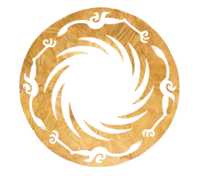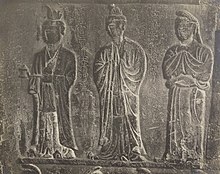Sichuanese people
This articlepossibly containsoriginal research.(December 2021) |
 TheGolden Sun Bird,a rediscovered artifact of theBa–Shu culture,believed to be a totem of theancient Shupeople,[1]and the emblem ofChengdusince 2011.[2] | |
| Regions with significant populations | |
|---|---|
| Mainland China | Sichuan Chongqing |
| Taiwan | As part ofMainlanderpopulation |
| Languages | |
| HistoricallyBa–Shu Chinese,also known as Old Sichuanese. PresentlySichuanesedialects ofSouthwestern Mandarin. | |
| Religion | |
| TraditionallyMahayana Buddhism,Taoism,ConfucianismandChinese folk religion,but alsoChristianity(seeChristianity in Sichuan) andIslam(seeIslam in Sichuan) | |
| Related ethnic groups | |
| otherHan Chinese,Yi people,Tujia people,Qiang people | |
TheSichuanese people[a]are aHan Chinese subgroupcomprising most of the population of China'sSichuanprovince and theChongqingmunicipality.
History[edit]
Beginning from the 9th century BC, theKingdom of Shu(on theChengdu Plain) and theState of Ba(which had its first capital atEnshi CityinHubeiand controlled part of theHan Valley) emerged as cultural and administrative centers where two rival kingdoms were established. In 316 BC, the two kingdoms were destroyed by theState of Qin.After theQin conquest of the six warring states,thenewly formed empirecarried out a forced resettlement.[3]The now-extinctBa–Shu languagewas derived from Qin-era settlers and represents the earliest documented division fromMiddle Chinese.
South Sichuan was also inhabited by theDai peoplewho formed theserfsclass. They were later thoroughly sinicized, adopting the local language of speech. Large numbers of foreign merchant families fromSogdia,Persiaand other Central Asian countries immigrated to Sichuan.[4]A Sogdian temple is attested inChengdu.[5]
During theYuanandMingdynasties, the population of Sichuan, Chongqing had been reduced due to immigration, deportation and flight of refugees fleeing war and plague, new or returning settlers from modernHunan,Hubei,GuangdongandJiangxi,replacing the earlier spoken language with different languages they adopted from the former regions to form a new standard language off communication.[6][7][8]
Recent history[edit]
Many migrant workers from rural Sichuan have migrated to other parts of the country, where they often facediscriminationin employment, housing etc.[9]This is due to China's household registration policy and other parts of people from midwest China face the same problem.
Culture[edit]
Thecultfor supernatural forces and entities is a long-established tradition among the Sichuanese people, tracing its roots back to theancientBa–Shuera.Taoismplayed a major role since the late antiquity with the emergence of theWay of the Celestial Mastermovement.[10]Confucianismhad relatively little influence, because of Ba–Shu's remoteness from theZhongyuanregion (perceived as the birthplace of the Chinese civilization) and theQiluregion (birthplace of Confucius and the center of Confucianism).[11]The cultural characteristics of the Sichuanese people were described in the 2014 bookAll about Sichuanas "a 'heretical biography' that deviated from Confucian orthodoxy, a free-spirited cultural group that opposed, despised and subverted Confucian ethics and imperial autocracy."[12]
Language[edit]

The Sichuanese once spoke their own variety of spoken Chinese calledBa–Shu Chinese,or Old Sichuanese before it became extinct during the Ming dynasty. Now most of them speakSichuanese Mandarin.TheMinjiang dialectsare thought by some linguists to be a bona fide descendant of Old Sichuanese due to many characteristics of Ba–Shu Chinese phonology and vocabulary being found in the dialects,[13]but there is no conclusive evidence whether Minjiang dialects are derived from Old Sichuanese or Southwestern Mandarin.
Cuisine[edit]
Sichuan is well known for its spicy cuisine and use ofSichuan peppersdue to its more arid climate.
Notable people[edit]
Well known Sichuanese people are such as:
- Ba Jin(1904–2005), author and political activist
- Bai Ling(1966–), actress
- Chang Dai-chien(1899–1983), artist
- Zhang Qun(1889–1990), premier of the Republic of China
- Fala Chen(1982–), actress
- Chen Pokong(1963–), author, political commentator and democracy activist
- Chen Shou(233–297), official and writer
- Cheung Chung-kiu(1964–), business magnate
- Deng Xiaoping(1904–1997), revolutionary and paramount leader of China
- GAI(1988–), rapper, singer, and songwriter
- Guo Moruo(1892–1978), author, poet, historian, archaeologist, and government official
- Huang Jiguang(1931–1952), highly decorated soldier during the Korean War
- Jiang Zhuyun(1920–1949), revolutionary martyr
- Li Bai(701–762), poet
- Li Bifeng(1965–), activist, poet and Christian
- Li Shou-min, better known asHuanzhulouzhu(1902–1961), novelist of thexianxiafantasy genre
- Li Shunxian(c. 900–926),Persian-Sichuanesepoet
- Liu Yonghao(1952–), businessman
- Li Yifeng(1987–), actor and singer
- Li Yuchun(1984–), singer, songwriter, and actress
- Liao Yiwu(1958–), author, reporter, musician, poet, and critic of China's Communist regime
- Luo Ruiqing(1906–1978), army officer and politician
- Empress Dowager Ma (Southern Ming)(1578–1669), birth mother of theYongli Emperor,a convert to Roman Catholicism
- Sanyu (painter)(1901–1966)
- Song Cheng-tsi(1892–1955),Anglicanbishop
- Song Yonghua(1964–), scholar
- Su Shi(1037–1101), writer, poet, painter, calligrapher, pharmacologist, gastronome, and statesman
- Su Xun(1009–1066), writer
- Su Zhe(1039–1112), politician and essayist
- Tan Weiwei(1982–), singer and actress
- Tang Chun-i(1909–1978), philosopher and scholar
- Wang Jiujiang(1957–), painter
- Wang Jianlin(1954–), business magnate, investor, and philanthropist
- Wang Xiaoya(1968–), television host and media personality
- Wang Yi(1973–),Calvinistpastor and human rights advocate
- Xu Youyu(1947–), scholar
- Stephen Yang(1911–2007), surgeon, medical educator, andQuakerpeace activist
- Yang Xiong(53 BC – 18 AD), poet, philosopher, and politician
- Y. C. James Yen(1890/1893–1990), educator
- Lucy Yi Zhenmei(1815–1862),Roman Catholicsaint
- Yu Jie(1973–), Calvinist democracy activist
- Yue Yiqin(1914–1937), flying ace
- Zhang Lan(1872–1955), political activist
- Zhang Yong(1969/1970–), Singapore's richest man in 2019
- Zhao Yiman(1905–1936), resistance fighter
- Zheng Ji(1900–2010), nutritionist and pioneering biochemist
- Zhu De(1886–1976), ex-warlord, later revolutionary and father of thePeople's Liberation Army
- Zhuo Wenjun(fl. 2nd century BC), poet
- Zou Rong(1885–1905), revolutionary martyr
See also[edit]
- Erlang Shen
- Jinsha site
- Sanxingdui
- Sichuan opera
- Clothing in ancient Shu
- Catholic Church in Sichuan
- Protestantism in Sichuan
Notes[edit]
- ^Chinese:Tứ xuyên nhân;pinyin:Sìchuān rénorXuyên du nhân;Chuānyú rén,sometimes shortened toXuyên nhân;Sichuanese Pinyin:Si4cuan1ren2;former romanization:Szechwanese people
References[edit]
- ^Li, Hsing-jung; Fêng, Ming-i; Yü, Chih-yung (1 November 2014).Đạo du thật huấn khóa trình(in Chinese (Taiwan)). Taipei: E-culture. p. 331.ISBN9789865650346.
- ^Agafonov, Arthur; Rasskazova, Elena (2 June 2019)."Homeland of Pepper and Panda: Yin and Yang of the Chinese Hinterland".eastrussia.ru.Retrieved12 May2020.
- ^Barbieri-Low, Anthony J. (2021)."Coerced Migration and Resettlement in the Qin Imperial Expansion".Journal of Chinese History.5(Special Issue 2): 181–202.doi:10.1017/jch.2019.1.RetrievedMay 5,2024.
- ^Yao, Chongxin (2011). "Trung cổ thời kỳ ba thục địa khu đích túc đặc nhân tung tích" [Traces of the Sogdians in Medieval Sichuan].Trung cổ nghệ thuật tông giáo dữ tây vực lịch sử luận cảo[Papers on Art, History and Religion of the Western Regions during the Medieval Period] (in Simplified Chinese). Beijing: The Commercial Press. p. 281.ISBN978-7-100-07691-3.
- ^Vaissière, Étienne de la(2005) [2002]. "Chapter Five: In China — The Sogdians in Sichuan and Tibet".Sogdian Traders: A History(PDF).Translated by Ward, James. Leiden: Brill Publishers. p. 145.ISBN90-04-14252-5.Archived fromthe original(PDF)on March 2, 2022.
- ^James B. Parsons (1957). "The Culmination of a Chinese Peasant Rebellion: Chang Hsien-chung in Szechwan, 1644–46".The Journal of Asian Studies.16(3): 387–400.doi:10.2307/2941233.JSTOR2941233.
- ^Yingcong Dai (2009).The Sichuan Frontier and Tibet: Imperial Strategy in the Early Qing.University of Washington Press. pp. 16–.ISBN978-0-295-98952-5.
- ^Entenmann, Robert Eric (1982).Migration and settlement in Sichuan, 1644-1796.Harvard University.
- ^Handbook of Chinese Migration: Identity and Wellbeing
- ^Yuan, Tingdong (1998). "Đệ thất chương tông giáo" [Chapter VII: Religion].Ba thục văn hóa chí[Cultural History of Ba–Shu] (in Simplified Chinese). Shanghai: Shanghai People's Press. pp. 241–250.ISBN7-208-02269-0.
- ^"Quách mạt nhược dữ ba thục văn hóa"[Guo Moruo and Ba–Shu culture].wxg.org.cn(in Simplified Chinese).RetrievedMay 5,2024.
- ^Li, Zhongdong; Tan, Yibo (2014).Thiên hạ tứ xuyên[All about Sichuan] (in Simplified Chinese). Beijing: China Tourism Press.ISBN9787503248948.
- ^Thí luận tống đại ba thục phương ngôn dữ hiện đại tứ xuyên phương ngôn đích quan hệ 》 "> lưu hiểu nam ( 2009 niên đệ 8 quyển đệ 6 kỳ ), 《 thí luận tống đại ba thục phương ngôn dữ hiện đại tứ xuyên phương ngôn đích quan hệ —— kiêm đàm văn hiến khảo chứng đích nhất cá trọng yếu công dụng: Truy tầm thất lạc đích phương ngôn 》, ngữ ngôn khoa học


